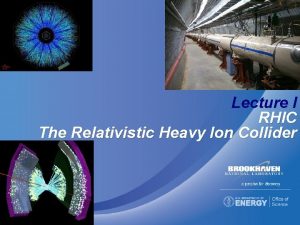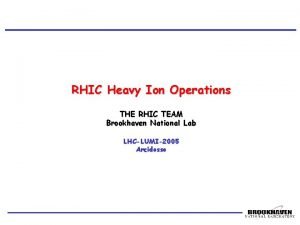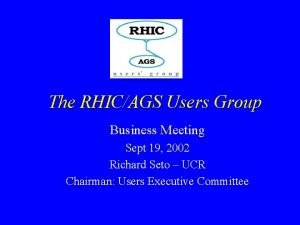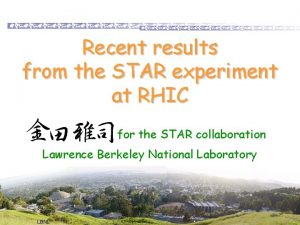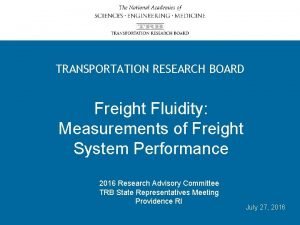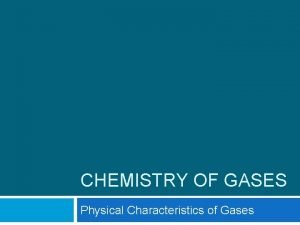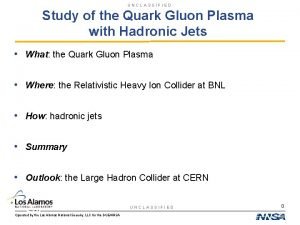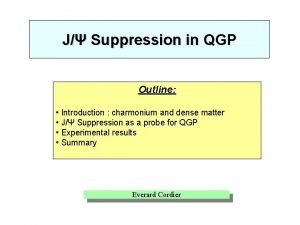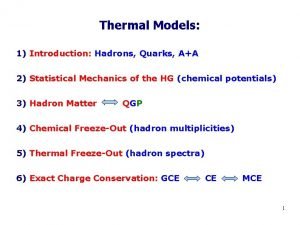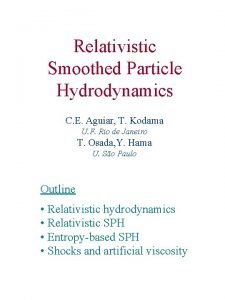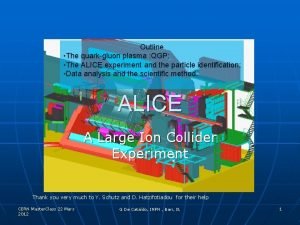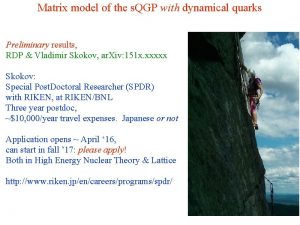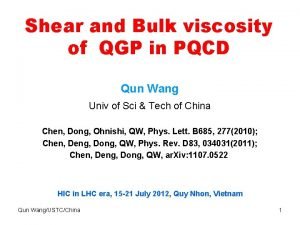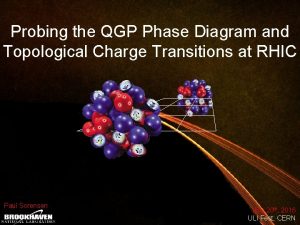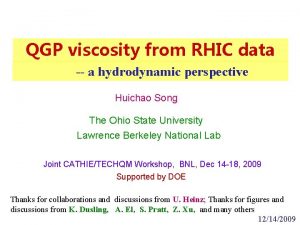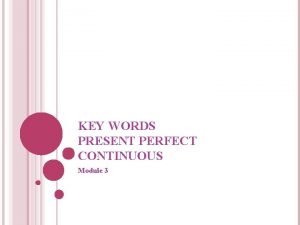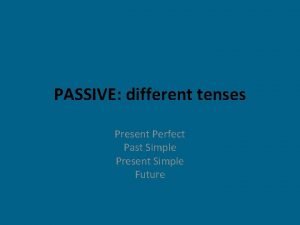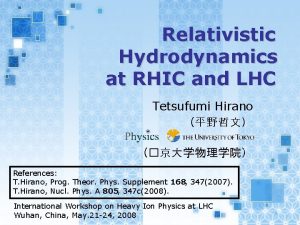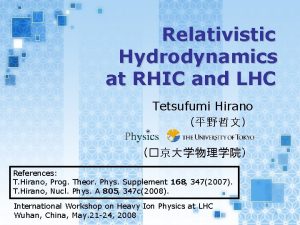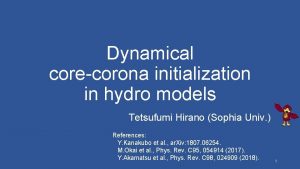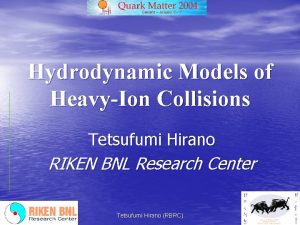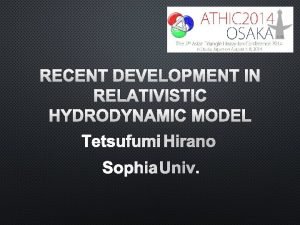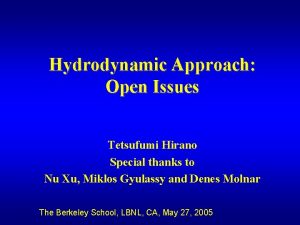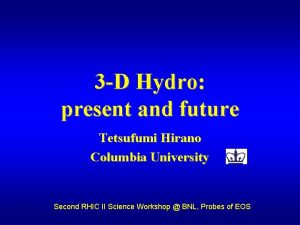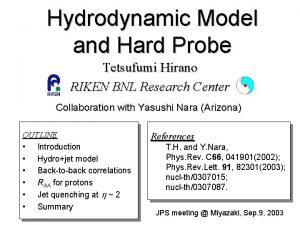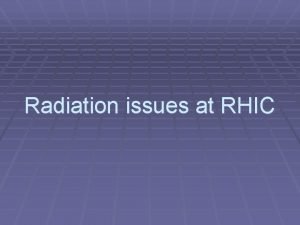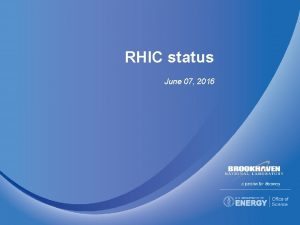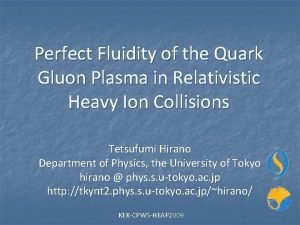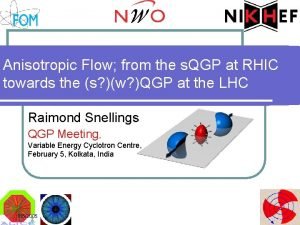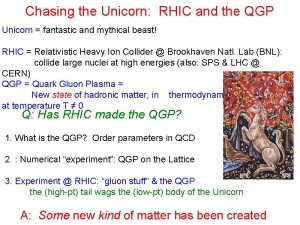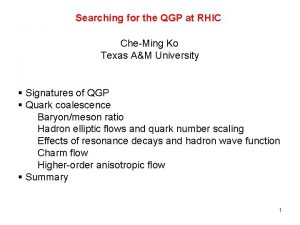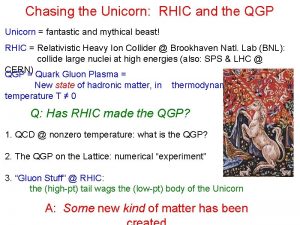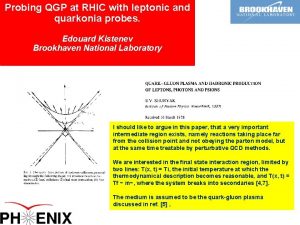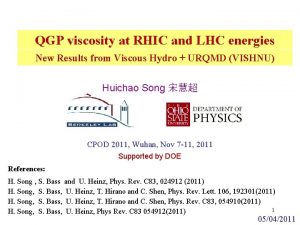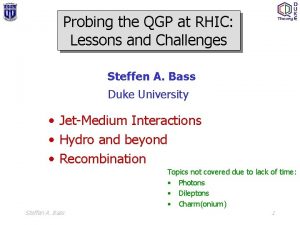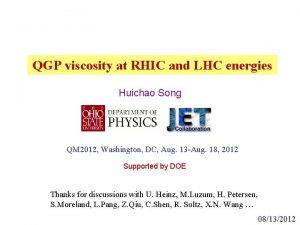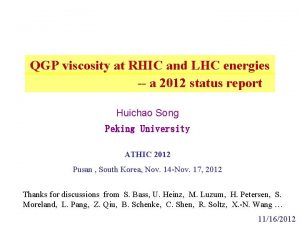Perfect Fluidity of QGP at RHIC Tetsufumi Hirano















![Digression [Pa] = [N/m 2] (Dynamical) Viscosity h: ~1. 0 x 10 -3 [Pa Digression [Pa] = [N/m 2] (Dynamical) Viscosity h: ~1. 0 x 10 -3 [Pa](https://slidetodoc.com/presentation_image_h2/c17be2c56b9c6eebcea24b0d83333d4f/image-16.jpg)









- Slides: 25

Perfect Fluidity of QGP at RHIC? Tetsufumi Hirano 平野哲文 Institute of Physics University of Tokyo �京大学 Komaba, Tokyo 153 -8902, Japan References: T. Hirano and M. Gyulassy, Nucl. Phys. A 769(2006)71. T. Hirano, U. Heinz, D. Kharzeev, R. Lacey, Y. Nara, Phys. Lett. B 636 (2006)299.

OUTLINE • “RHIC serves the perfect liquid” • Elliptic flow • Results from hydro + cascade model • Ratio of viscosity to entropy • Summary


What is “Perfect Liquid”? A possibility of “Perfect Liquid QGP” is intriguing. In this context, a lot of people say, “QGP viscosity is small”. Viscosity is “small” in comparison with …, what? ? ? I will discuss this issue later.

What is Elliptic Flow? Ollitrault (’ 92) How does the system respond to spatial anisotropy? No secondary interaction Hydro behavior y f INPUT x Spatial Anisotropy 2 v 2 OUTPUT d. N/df Interaction among produced particles Momentum Anisotropy 0 f 2 p

Elliptic Flow from a Kinetic Theory ideal hydro limit Zhang et al. (’ 99) v 2 Time evolution of v 2 View from collision axis b = 7. 5 fm t(fm/c) • Gluons uniformly distributed in the overlap region • d. N/dy ~ 300 for b = 0 fm • Thermal distribution with T = 500 Me. V generated through secondary collisions v 2 is saturated in the early stage sensitive to cross section (~m. f. p. ~viscosity)

TH&Gyulassy(’ 06), TH, Heinz, Kharzeev, Lacey, Nara(’ 06) Hydro Meets Data for the First Time at RHIC: “Current” Three Pillars 1. Perfect Fluid (s)QGP Core • Ideal hydro description of the QGP phase • Necessary to gain integrated v 2 2. Dissipative Hadronic Corona • • • Boltzmann description of the hadron phase Necessary to gain enough radial flow Necessary to fix particle ratio dynamically 3. Glauber Type Initial Condition • Diffuseness of initial geometry A Lack of each pillar leads to discrepancy!

TH et al. (’ 05 -) (CGC +)QGP Hydro+Hadronic Cascade Hadronic Corona (Cascade, JAM) t 0. 6 fm/c z 0 c. f. Similar approach by Nonaka and Bass (DNP 04, QM 05) s. QGP core (Full 3 D Ideal Hydro) (Option) Color Glass Condensate

(1) Glauber and (2) CGC Hydro Initial Conditions Which Clear the First Hurdle Centrality dependence Rapidity dependence • Glauber model Npart: Ncoll = 85%: 15% • CGC model Matching I. C. via e(x, y, h)

p. T Spectra for identified hadrons from QGP Hydro+Hadronic Cascade d. N/dy and d. N/dp. T are o. k. by hydro+cascade. Caveat: Other components such as recombination and fragmentation should appear in the intermediate-high p. T regions.

TH et al. (’ 06) v 2(Npart) from QGP Hydro + Hadronic Cascade Glauber: ü Early thermalization ü Mechanism? CGC: ü No perfect fluid? ü Additional viscosity is required in QGP Result of JAM: Courtesy of M. Isse Importance of better understanding of initial condition

Large Eccentricity from CGC Initial Condition y x Pocket formula (ideal hydro): v 2 ~ 0. 2 e @ RHIC energies Ollitrault(’ 92)

v 2(p. T) for identified hadrons Glauber type initial condition Mass dependence is o. k. CGC initial condition v 2(model) > v 2(data)

Viscosity and Entropy • Reynolds number where Iso, Mori, Namiki (’ 59) R>>1 Perfect fluid • 1+1 D Bjorken flow Bjorken(’ 83) Baym(’ 84)Hosoya, Kajantie(’ 85)Danielewicz, Gyulassy(’ 85)Gavin(’ 85)Akase et al. (’ 89)Kouno et al. (’ 90)… (Ideal) (Viscous) h : shear viscosity (Me. V/fm 2), s : entropy density (1/fm 3) h/s is a good dimensionless measure (in the natural unit) to see viscous effects.

Why QGP Fluid + Hadron Gas Works? TH and Gyulassy (’ 06) h : shear viscosity, s : entropy density Kovtun, Son, Starinets(’ 05) • Absolute value of viscosity • Its ratio to entropy density ! Rapid increase of entropy density can make hydro work at RHIC. Deconfinement Signal? !
![Digression Pa Nm 2 Dynamical Viscosity h 1 0 x 10 3 Pa Digression [Pa] = [N/m 2] (Dynamical) Viscosity h: ~1. 0 x 10 -3 [Pa](https://slidetodoc.com/presentation_image_h2/c17be2c56b9c6eebcea24b0d83333d4f/image-16.jpg)
Digression [Pa] = [N/m 2] (Dynamical) Viscosity h: ~1. 0 x 10 -3 [Pa s] (Water 20℃) ~1. 8 x 10 -5 [Pa s] (Air 20℃) Kinetic Viscosity n=h/r: ~1. 0 x 10 -6 [m 2/s] (Water 20℃) ~1. 5 x 10 -5 [m 2/s] (Air 20℃) hwater > hair BUT nwater < nair Non-relativistic Navier-Stokes eq. (a simple form) Neglecting external force and assuming incompressibility.

Summary • Perfect Fluid QGP + Dissipative Hadron + Glauber initial conditions does a good job. – Manifestation of deconfinement? • CGC initial conditions spoil this agreement. • Viscous QGP may compensate “CGC effect”. • Importance of better understanding initial conditions. To be or not to be (consistent with hydro), that is THE question. --Anonymous

Thank you! TH&Gyulassy(’ 06) QGP mixed hadron Energy density in the transverse plane at midrapidity Energy in (four-)velocity plane at midrapidity

Viscosity from a Kinetic Theory See, e. g. Danielewicz&Gyulassy(’ 85) For ultra-relativistic particles, the shear viscosity is Ideal hydro: l 0 Transport cross section shear viscosity 0

A Long Time Ago… …we obtain the value R (Reynolds number)=1~10… Thus we may infer that the assumption of the perfect fluid is not so good as supposed by Landau.

A Final Piece of RHIC Jigsaw Puzzle? or Glauber A much better understanding of initial condition is desperately needed. Distinguish via 3 D jet tomography Adil, Gyulassy and TH (’ 06) CGC Or any other possible scenarios based on non-equilibrium models, instabilities, etc. for thermalization / isotropization mechanism.

Results from Hydro + Cascade (III) Glauber-BGK CGC

v 2(p. T) from Hydro: Past, Present and Future 2000 (Heinz, Huovinen, Kolb…) Ideal hydro w/ chem. eq. hadrons 2002 (TH, Teaney, Kolb…) +Chemical freezeout 2002 (Teaney…) +Dissipation in hadron phase 2005 (BNL) “RHIC serves the perfect liquid. ” 2004 -2005 (TH, Gyulassy) Mechanism of v 2(p. T) slope 2005 -2006(TH, Heinz, Nara, …) +Color glass condensate Future “To be or not to be (consistent with hydro), that is THE question” -- anonymous XXXXXXXXXXXXXX ? ? ? ? ? 20 -30% History of differential elliptic flow ~History of development of hydro ~History of removing ambiguity in hydro

Temperature Dependence of h/s • Shear Viscosity in Hadron Gas Danielewicz&Gyulassy(’ 85) • Assumption: h/s at Tc in the s. QGP is 1/4 p Kovtun, Son, Starinets(‘ 05) No big jump in viscosity at Tc! • We propose a possible scenario:

Ideal QGP Fluid + Dissipative Hadron Gas Models hydro (1+1)D with cascade Ur. QMD Bjorken flow A. Dumitru et al. , PLB 460, 411(1999); PRC 60, 021902(1999); S. Bass and A. Dumitru, PRC 61, 064909(2000). RQMD N/A JAM N/A (2+1)D with Bjorken flow N/A D. Teaney et al. , PRL 86, 4783(2001), nucl-th/0110037; D. Teaney, nucl-th/0204023. N/A Full (3+1)D C. Nonaka and S. Bass, nucl-th/0510038. N/A TH, U. Heinz, D. Kharzeev, R. Lacey, and Y. Nara, PLB 636299(2006).
 Funcion publica peru
Funcion publica peru Gks hesaplama
Gks hesaplama Orbital revolution
Orbital revolution Rhic brookhaven
Rhic brookhaven Rhic ags users meeting 2020
Rhic ags users meeting 2020 Rhic
Rhic Fluidity operations llc
Fluidity operations llc Fluidity in a sentence
Fluidity in a sentence Office interface vs industrial interface
Office interface vs industrial interface Fluidity of gas
Fluidity of gas Qgp llc
Qgp llc Qgp
Qgp Tokyo gce
Tokyo gce Speric shock
Speric shock Qgp
Qgp Qgp
Qgp Qgp
Qgp Qgp phase diagram
Qgp phase diagram Qgp
Qgp He has ha hemos
He has ha hemos Past perfect progressive use
Past perfect progressive use Keywords for present perfect tense
Keywords for present perfect tense Present perfect present perfect continuous past simple
Present perfect present perfect continuous past simple Past simple passive
Past simple passive Present perfect tense vs present perfect continuous tense
Present perfect tense vs present perfect continuous tense Future perfect continuous tense examples pdf
Future perfect continuous tense examples pdf


